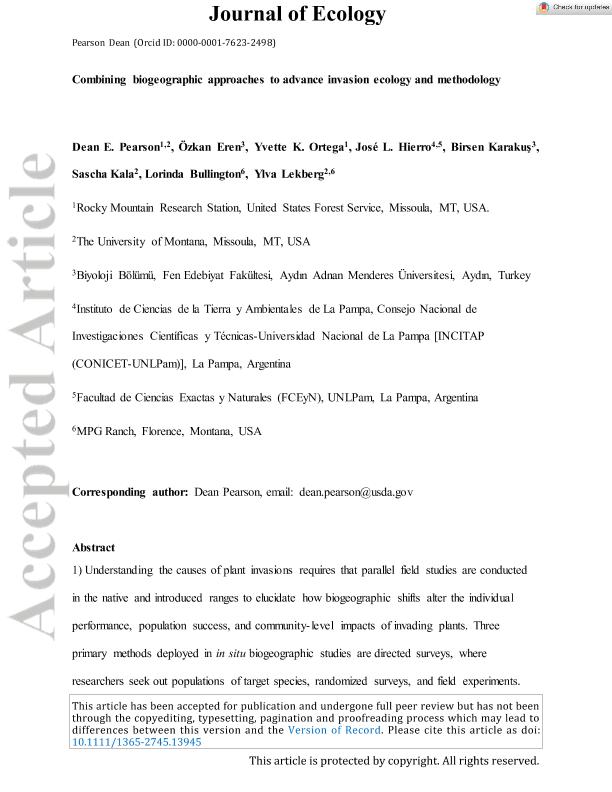Mostrar el registro sencillo del ítem
dc.contributor.author
Pearson, Dean

dc.contributor.author
Eren, Ozkan

dc.contributor.author
Ortega, Yvette K.
dc.contributor.author
Hierro, Jose Luis

dc.contributor.author
Karakuş, Birsen
dc.contributor.author
Kala, Sascha
dc.contributor.author
Bullington, Lorinda
dc.contributor.author
Lekberg, Ylva
dc.date.available
2023-09-22T17:02:24Z
dc.date.issued
2022-06
dc.identifier.citation
Pearson, Dean; Eren, Ozkan; Ortega, Yvette K.; Hierro, Jose Luis; Karakuş, Birsen; et al.; Combining biogeographical approaches to advance invasion ecology and methodology; Wiley Blackwell Publishing, Inc; Journal of Ecology; 110; 9; 6-2022; 2033-2045
dc.identifier.issn
0022-0477
dc.identifier.uri
http://hdl.handle.net/11336/212757
dc.description.abstract
Understanding the causes of plant invasions requires that parallel field studies are conducted in the native and introduced ranges to elucidate how biogeographical shifts alter the individual performance, population success and community-level impacts of invading plants. Three primary methods deployed in in situ biogeographical studies are directed surveys, where researchers seek out populations of target species, randomized surveys and field experiments. Despite the importance of these approaches for advancing biogeographical research, their relative merits have not been evaluated. We concurrently deployed directed surveys, randomized surveys and in situ field experiments for studying six grassland plant species in the native and introduced ranges. Metrics included plant size, fecundity, recruitment, abundance and invader impact, as well as soil properties and root associations with putative fungal mutualists and pathogens. Consistent with key invasion hypotheses, Bromus tectorum experienced increased size and fecundity in the introduced range linked to population increases and significant invader impacts, along with altered fungal associations. However, performance differences did not predict population increases and invader impacts across species. A notable finding was that disturbance facilitated greater recruitment in the introduced range for most species, thereby playing a crucial, though underappreciated, role in driving invader success. Directed surveys consistently generated information on plant performance and fungal associations. However, soil sampling suggested that directed surveys may have been biased towards disturbed conditions for half the species. Randomized surveys generated robust data for population comparisons and impact, but generally failed to produce performance metrics for species that were uncommon or flowered outside the peak sampling window. Field experiments controlled for bias and confounding factors and provided rare information on recruitment and disturbance effects, but poor recruitment in the native range and ethical constraints on growing invaders in the introduced range hindered comparisons of performance and plant–fungal interactions. Synthesis. Each method had strengths and weaknesses. However, when combined they provided complementary information to paint the most complete biogeographical picture to date for several introduced plants. We propose a hybrid approach to optimize biogeographical studies.
dc.format
application/pdf
dc.language.iso
eng
dc.publisher
Wiley Blackwell Publishing, Inc

dc.rights
info:eu-repo/semantics/openAccess
dc.rights.uri
https://creativecommons.org/licenses/by-nc-sa/2.5/ar/
dc.subject
BROMUS TECTORUM
dc.subject
FECUNDITY
dc.subject
INVADER IMPACT
dc.subject
INVASIVE PLANTS
dc.subject
MUTUALISTS
dc.subject
PATHOGENS
dc.subject
PLANT PERFORMANCE
dc.subject
PLANT SIZE
dc.subject
POPULATION DENSITY
dc.subject
RECRUITMENT
dc.subject
SOIL NUTRIENTS
dc.subject.classification
Ecología

dc.subject.classification
Ciencias Biológicas

dc.subject.classification
CIENCIAS NATURALES Y EXACTAS

dc.title
Combining biogeographical approaches to advance invasion ecology and methodology
dc.type
info:eu-repo/semantics/article
dc.type
info:ar-repo/semantics/artículo
dc.type
info:eu-repo/semantics/publishedVersion
dc.date.updated
2023-07-05T15:27:57Z
dc.journal.volume
110
dc.journal.number
9
dc.journal.pagination
2033-2045
dc.journal.pais
Reino Unido

dc.journal.ciudad
Londres
dc.description.fil
Fil: Pearson, Dean. University of Montana; Estados Unidos. United States Forest Service. Rocky Mountain Research Station; Argentina
dc.description.fil
Fil: Eren, Ozkan. Adnan Menderes Universitesi; Turquía
dc.description.fil
Fil: Ortega, Yvette K.. United States Forest Service. Rocky Mountain Research Station; Argentina
dc.description.fil
Fil: Hierro, Jose Luis. Consejo Nacional de Investigaciones Científicas y Técnicas. Instituto de Ciencias de la Tierra y Ambientales de La Pampa. Universidad Nacional de La Pampa. Facultad de Ciencias Exactas y Naturales. Instituto de Ciencias de la Tierra y Ambientales de La Pampa; Argentina
dc.description.fil
Fil: Karakuş, Birsen. Adnan Menderes Universitesi; Turquía
dc.description.fil
Fil: Kala, Sascha. University of Montana; Estados Unidos
dc.description.fil
Fil: Bullington, Lorinda. Mpg Ranch; Estados Unidos
dc.description.fil
Fil: Lekberg, Ylva. University of Montana; Estados Unidos. Mpg Ranch; Estados Unidos
dc.journal.title
Journal of Ecology

dc.relation.alternativeid
info:eu-repo/semantics/altIdentifier/url/https://besjournals.onlinelibrary.wiley.com/doi/10.1111/1365-2745.13945
dc.relation.alternativeid
info:eu-repo/semantics/altIdentifier/doi/http://dx.doi.org/10.1111/1365-2745.13945
Archivos asociados
